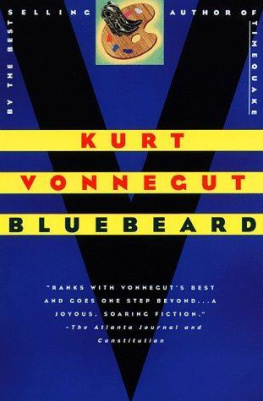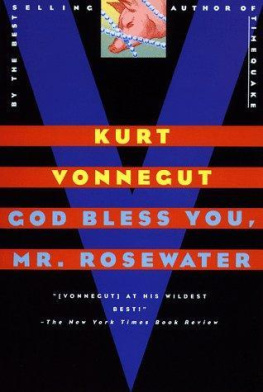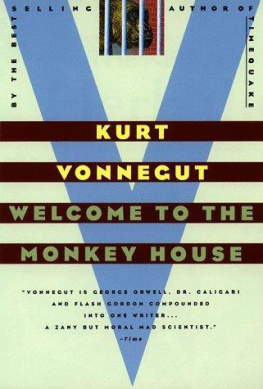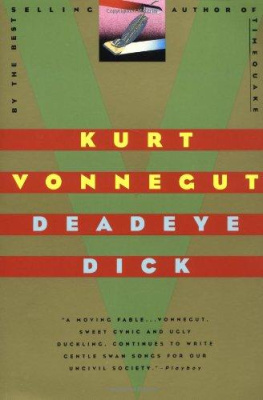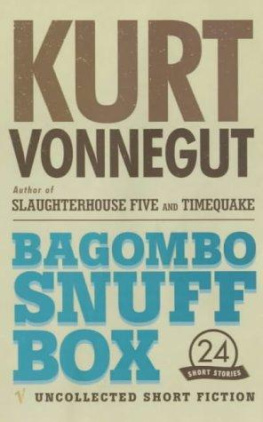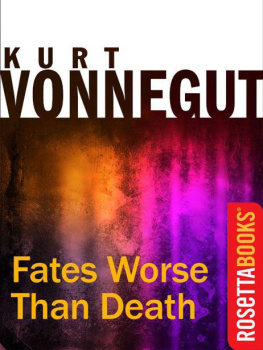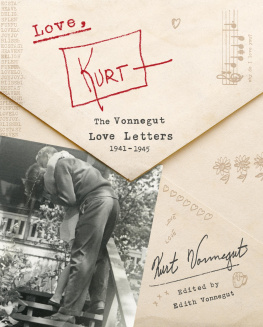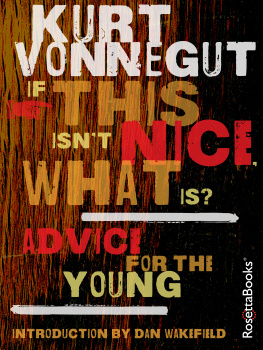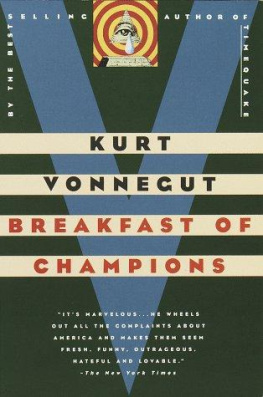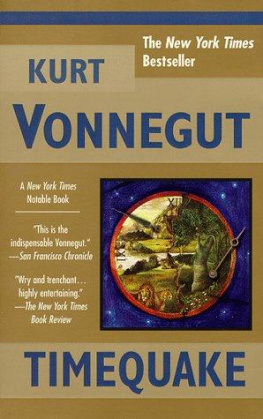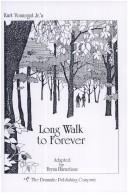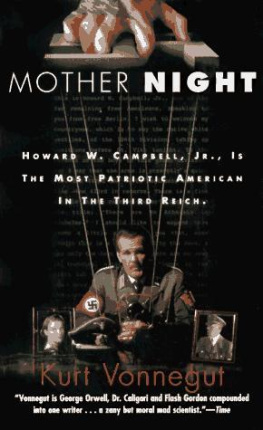BluebeardThe Autobiography of Rabo Karabekian (1916-1988)
by Kurt Vonnegut
a.b.e-book v3.0 / Notes at EOF
Back Cover:
"Vonnegut is at his edifying best!" -- The Philidelphia Inquirer Kurt Vonnegut is a master of contemporary American literature. His black humor, satiric voice, and incomparable imagination first captured America's attention in The Sirens of Titan in 1959 and established him as "a true artist" with Cat's Cradle in 1963. He is, as Graham Greene has declared, "one of the best living American writers." Bluebeard ranks with Vonnegut's most imaginative works. Broad humor and bitter irony collide in this fictional autobiography of Rabo Karabekian, who, at seventy-one, wants to be left alone at his Long Island estate with the secret he has locked inside his potato barn. But then a voluptuous young widow badgers him into telling his life story --and Vonnegut tells us the plain, heart-hammering truth about man's careless fancy to create or destroy what he loves.
"Vonnegut is George Orwell, Dr. Caligari and Flash Gordon compounded into one writer... A zany but moral mad scientist." -- Time
A DELTA BOOK
Published by
Dell Publishing
a division of
Bantam Doubleday Dell Publishing Group, Inc.
1540 Broadway
New York, New York 10036
This novel is a work of fiction. Names, characters, places, and
incidents either are the product of the author's imagination or are used fictitiously. Any resemblance to actual persons, living or dead, events, or locales is entirely coincidental.
Cover design: Carin Goldberg
Cover illustration: Gene Greif
Book design: Nancy Field
Copyright 1987 by Kurt Vonnegut
All rights reserved. No part of this book may be reproduced or
transmitted in any form or by any means, electronic or mechanical, including photocopying, recording, or by any information storage
and retrieval system, without the written permission of the
Publisher, except where permitted by law. For information address: Delacorte Press, New York, New York.
The trademark Delta is registered in the U.S. Patent and
Trademark Office and in other countries.
ISBN: 0-385-33351-X
Reprinted by arrangement with Delacorte Press
Manufactured in the United States of America
Published simultaneously in Canada
October 1998
10 9 8 7 6
BVG
Author's Note
This is a novel, and a hoax autobiography at that. It is not to be taken as a responsible history of the Abstract Expressionist school of painting, the first major art movement to originate in the United States of America. It is a history of nothing but my own idiosyncratic responses to this or that.
Rabo Karabekian never lived, and neither did Terry Kitchen or Circe Berman or Paul Slazinger or Dan Gregory or Edith Taft or Marilee Kemp or any of the other major characters in this book. As for real and famous persons I mention: I have them do nothing that they did not actually do when tested on this proving ground.
May I say, too, that much of what I put in this book was inspired by the grotesque prices paid for works of art during the past century. Tremendous concentrations of paper wealth have made it possible for a few persons or institutions to endow certain sorts of human playfulness with inappropriate and hence distressing seriousness. I think not only of the mudpies of art, but of children's games as well --running, jumping, catching, throwing.
Or dancing.
Or singing songs.
K. V.
"We are here to help each other get through this thing, whatever it is."
--Dr. Mark Vonnegut, M.D.
( Letter to Author, 1985)
This book is for Circe Berman.
What else can I say?
R.K.
HAVING WRITTEN "The End" to this story of my life, I find it prudent to scamper back here to before the beginning, to my front door, so to speak, and to make this apology to arriving guests: "I promised you an autobiography, but something went wrong in the kitchen. It turns out to be a diary of this past troubled summer, too! We can always send out for pizzas if necessary. Come in, come in."
* * *
I am the erstwhile American painter Rabo Karabekian, a one-eyed man. I was born of immigrant parents in San Ignacio, California, in 1916. I begin this autobiography seventy-one years later. To those unfamiliar with the ancient mysteries of arithmetic, that makes this year 1987.
I was not born a cyclops. I was deprived of my left eye while commanding a platoon of Army Engineers, curiously enough artists of one sort or another in civilian life, in Luxembourg near the end of World War Two. We were specialists in camouflage, but at that time were fighting for our lives as ordinary infantry. The unit was composed of artists, since it was the theory of someone in the Army that we would be especially good at camouflage. And so we were! And we were! What hallucinations we gave the Germans as to what was dangerous to them behind our lines, and what was not. Yes, and we were allowed to live like artists, too, hilariously careless in matters of dress and military courtesy. We were never attached to a unit as quotidian as a division or even a corps. We were under orders which came directly from the Supreme Headquarters of the Allied Expeditionary Force, which assigned us temporarily to this or that general, who had heard of our astonishing illusions. He was our patron for just a little while, permissive and fascinated and finally grateful. Then off we went again.
Since I had joined the regular Army and become a lieutenant two years before the United States backed into the war, I might have attained the rank of lieutenant colonel at least by the end of the war. But I refused all promotions beyond captain in order to remain with my happy family of thirty-six men. That was my first experience with a family that large. My second came after the war, when I found myself a friend and seeming peer of those American painters who have now entered art history as founders of the Abstract Expressionist school.
* * *
My mother and father had families bigger than those two of mine back in the Old World - and of course their relatives back there were blood relatives. They lost their blood relatives to a massacre by the Turkish Empire of about one million of its Armenian citizens, who were thought to be treacherous for two reasons: first because they were clever and educated, and second because so many of them had relatives on the other side of Turkey's border with its enemy, the Russian Empire.
It was an age of Empires. So is this one, not all that well disguised.
* * *
The German Empire, allied with the Turks, sent impassive military observers to evaluate this century's first genocide, a word which did not exist in any language then. The word is now understood everywhere to mean a carefully planned effort to kill every member, be it man, woman, or child, of a perceived subfamily of the human race.
The problems presented by such ambitious projects are purely industrial: how to kill that many big, resourceful animals cheaply and quickly, make sure that nobody gets away, and dispose of mountains of meat and bones afterwards. The Turks, in their pioneering effort, had neither the aptitude for really big business nor the specialized machinery required. The Germans would exhibit both par excellence only one quarter of a century later. The Turks simply took all the Armenians they could find in their homes or places of work or refreshment or play or worship or education or whatever, marched them out into the countryside, and kept them away from food and water and shelter, and shot and bashed them and so on until they all appeared to be dead. It was up to dogs and vultures and rodents and so on, and finally worms, to clean up the mess afterwards.
Next page 
